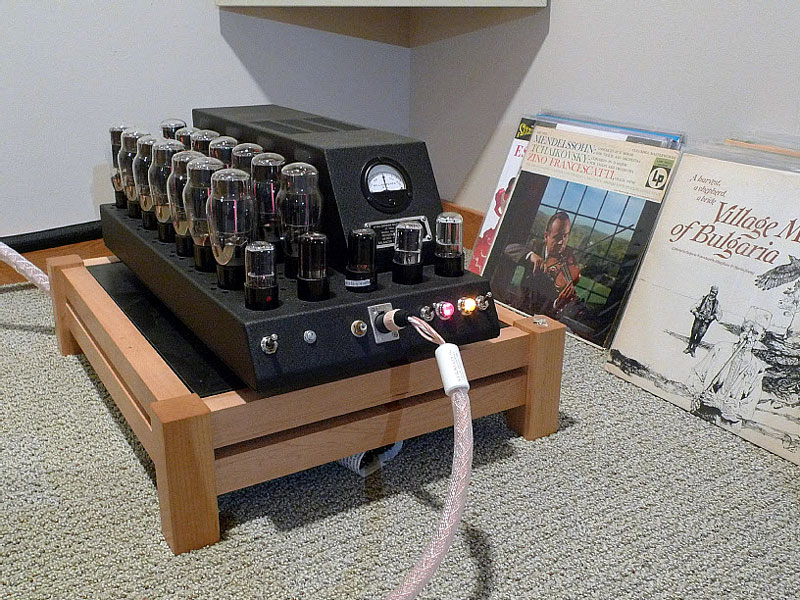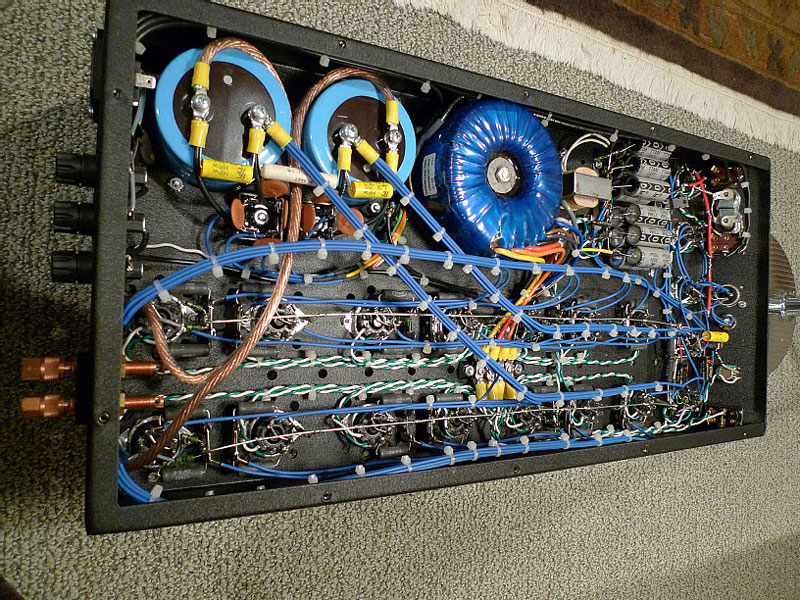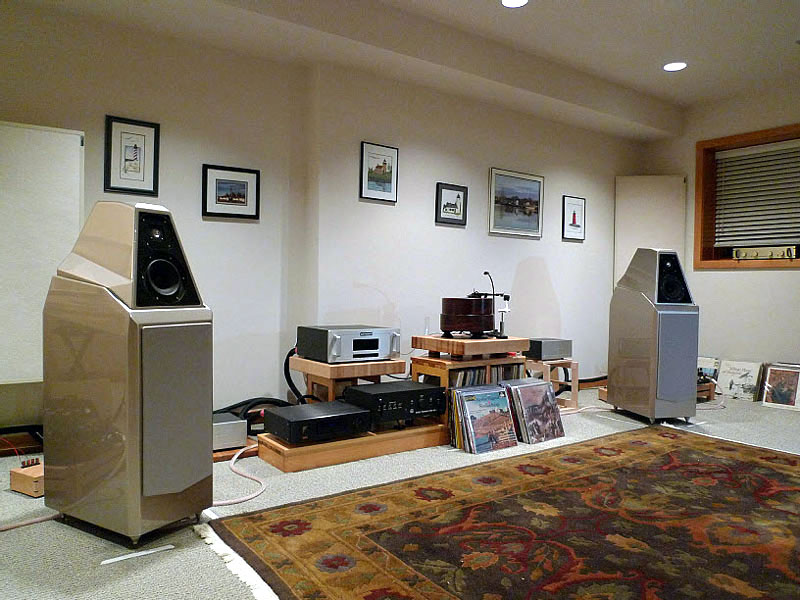Mk 3.1: More Than "Another Upgrade"
he longevity of Atma-Sphere Music Systems is no accident. The company operates from simple premises: pursue nothing less than state-of-the-art sonic reproduction, treat customers as you would want to be treated, and make obsolescence a thing of the past. Today’s Atma-Sphere amps reflect a continuity of improvement on an output-transformerless (OTL) design that dates back to the company’s founding in 1977. If you own an early amp, Atma-Sphere can bring it to current Mk 3.1 status. If that’s not enough, each upgraded amp also comes with a new three-year warranty.
Upgrading a pair of MA-1 monoblocks from Mk 3 to Mk 3.1, which is what happened with my amps, costs $350 for the pair. The cost is higher for older pairs of the amps, while brand-new MA-1 Mk 3.1 monoblocks cost $16,200/pair. The bottom-line for this upgrade is, according to Atma-Sphere, a scope-measured 90% drop in distortion for an amp running close to full power. The amp’s total harmonic distortion -- that measurement of extraneous unwanted harmonics added to a signal by the electronics themselves -- is less than 1% at full power. Spurious frequency-emission byproducts -- aka, intermodulation distortion -- measure at less than 0.005% at full output. Among amps that use zero loop negative feedback, Ralph Karsten claims that the Mk 3.1 MA-1 is the lowest-distortion tube amp he has encountered. And after thirty years in business, Ralph has encountered a lot of tube amps. You’d think that working on the same design for all that time would leave few avenues unexplored, but Ralph offered this about the creative process in his design work: "I can't say that it’s any one thing that does the trick. Improvements have come from the field, but mostly I'm always just trying to see how I can push the technology. Since there isn't anyone else out there who works much in the areas that I do, I've often felt like I was on my own. There are mathematical models of course, but I've developed an empirical bench technique that seems to work pretty well." As my grandmother might say, "That Ralph, he keeps agoing."
The upgrade did not involve changing out parts. Ralph hinted that getting to Mk 3.1 required flaunting conventional wisdom. The Atma-Sphere circuit -- the patented "Balanced Differential Design" used for all of Ralph's amps -- uses two pairs of 6SN7 triodes to form a differential cascode amplifier that composes the MA-1’s sole voltage gain stage. This cascode circuit ("cascode" being a contraction of "cascade to cathode") dates back to the 1940s, when the circuit's unique low-noise properties made it perfect for use in the early development of radar. While new topologies do appear in stereo electronics, much of high-end tube audio continues to draw on designs developed forty, fifty or sixty years ago, and today you’ll find similar cascodes in products from companies other than Atma-Sphere. Traditionally a cascode runs with a small amount of current to yield a high output impedance along with gain approaching that of a pentode. Taking his cue from a journal article about cascodes, Karsten broke with tradition by increasing the amount of current running through the gain stage. This was fundamentally counterintuitive to the original design, yet in his circuit the math worked. In Ralph’s words: "The increase in current had the following effects: greater linearity, increased gain, and wider bandwidth (associated with a lower output impedance of the circuit). This is really rare in analog circuits -- there is a trinity of sorts that usually exists between gain, distortion and bandwidth; to improve one is usually at a cost to one or both of the other." One authority Karsten will not question is what he calls the rules of human hearing, and these have little to do with specs on a piece of paper: "If you design your amp to look good on paper, it at best will sound like good hi-fi. What we really want is for it to sound like music. For that, we have to get the circuitry/stereo to obey as many of these perceptual rules as we know about." The breadth of Ralph’s research into these rules of hearing finds him drawing on luminaries such as 1950s design guru Norman Crowhurst, contemporary neuro-chemist Herbert Melcher, General Electric hearing studies, and chaos theorist Edward Lorenz. The designer’s challenge is to connect laboratory and field research that objectively quantify subjective listening with an implementation that reflects the lessons that research teaches. There is no logic of discovery or assured methodology to success. Lessons get learned over time through hard-won empirical evidence, bench tests and listening. Years ago I labeled Karsten a kaizen-master -- advancing the state of the art in .1 baby steps. He’s still at it. From Melcher’s work comes a corollary that the pleasure we take from listening to music is rooted deep in primitive limbic functions of awareness. Aaron Copland, the American composer, tells us in his book What to Listen for in Music that a fundamental aspect of listening takes place on a "sensuous plane" -- "a kind of brainless but attractive state of mind [that] is engendered by the mere sound appeal of music." Discrimination of music as live versus reproduced is (for me, anyway) non-cognitive. It comes from ancient roots: when a twig snaps, there’s no time for syllogizing. We’re stuck with the ears we have and the perceptual rules that govern them. Extra-musical noise caused by the electronics of reproduction can yield harsh sound and a loss of detail, yet its absence can be more conspicuous than its presence, especially in resolving systems that sound good to start with. Harshness can manifest itself in varying ways. We audiophiles use words such as "hard," "glassy," "bright," or "etched" to describe it. Unmasked detail gets revealed across a continuum -- from previously unheard sounds and musical passages to subtle signals we may not identify directly but which our ears resolve as closer to the live experience.
In the listening room, things are more complex -- but not by much. When I hear a component that makes me think about it in some way, breaking the limbic bond and skewing the "attractive state," I find myself less interested in the music it conveys. Is it a stretch to say that sonic distortion leads to analytical assessment, acting as its own propagation delay on bliss? I owned the MA-1 Mk 3s for about five years. When they returned from Minnesota after upgrading, the only hint they’d been gone were new nameplates with Mk 3.1 nomenclature. Into the second hour of warm up, my ears innocent of expectation, I set stylus to groove and headed for the couch. Three steps later my headed snapped with involuntarily recognition. The amps were quieter and the music was clearer, more detailed and more at ease with itself, with a heightened sense of continuity and rhythmic rightness. Through the upgraded MA-1s, music suddenly lacked any sense of rough-edged angularity -- something I hadn’t known I was hearing until it was gone. My listening notes spoke to enhanced transient fidelity from plucked bass and particularly from percussion -- snare drums, wood blocks, maracas, even bongos and congas. Side two of Paul Simon’s Rhythm of the Saints [Warner Bros. W1-26098] told the tale, its bevy of South American percussion snapping and slapping with shifting dynamics along a liquid river of rhythm. This sense of continuity-with-articulation coupled with the MA-1 Mk 3.1s' native quickness and transformerless immediacy delivered music with a new naturalness and vitality that belied its electronic origination. Transients and high-frequency detail lend to enhanced phase discrimination -- an event ultimately occurring at our ears and whose products are informed cues for discerning soundstage breadth and depth. Listening to "Born at the Right Time," I heard the chorus firmly anchored over Simon’s left shoulder as congas cascaded well beyond the boundaries of the left-hand Wilson Sasha. These were not performer-positioning discoveries; the 3.1 upgrade simply uncovered enough detail to broaden the soundstage and lend a new sense of resoluteness to image placement. Some folks claim Willie Greene, Jr. can hit notes below the bottom C on a piano -- heck, a lot of speakers are lucky to go so low. When he sings with Aaron Neville on "It Feels Like Rain" from Warm Your Heart [A&M/Classic Records RTH5354], I heard how the Mk 3.1s uncovered not only Willie himself waaay down in the mix located in the middle of a line of backup singers, but how they pulled to the surface the rich, note-variant tonality of his basso profundo. The MA-1s have always offered superb mid-note tonal depth and completeness. With the 3.1 upgrade, fundamentals gained further clarity and approached pitch perfection. Once I heard these upgraded amps, I knew the bar of
expectation for lifelike sound had been raised. Going forward, there was no way my ears
would accept less. Thirty years in business is no accident, as Ralph’s words came
back to me: "Anytime you can measure a change and also hear it, you have something
that is real." Here is how our hobby advances empirically and incrementally. The
Mk3.1 upgrade is available for any Atma-Sphere amp, and, to my ears, it falls clearly on
the plus side of the value equation. |



